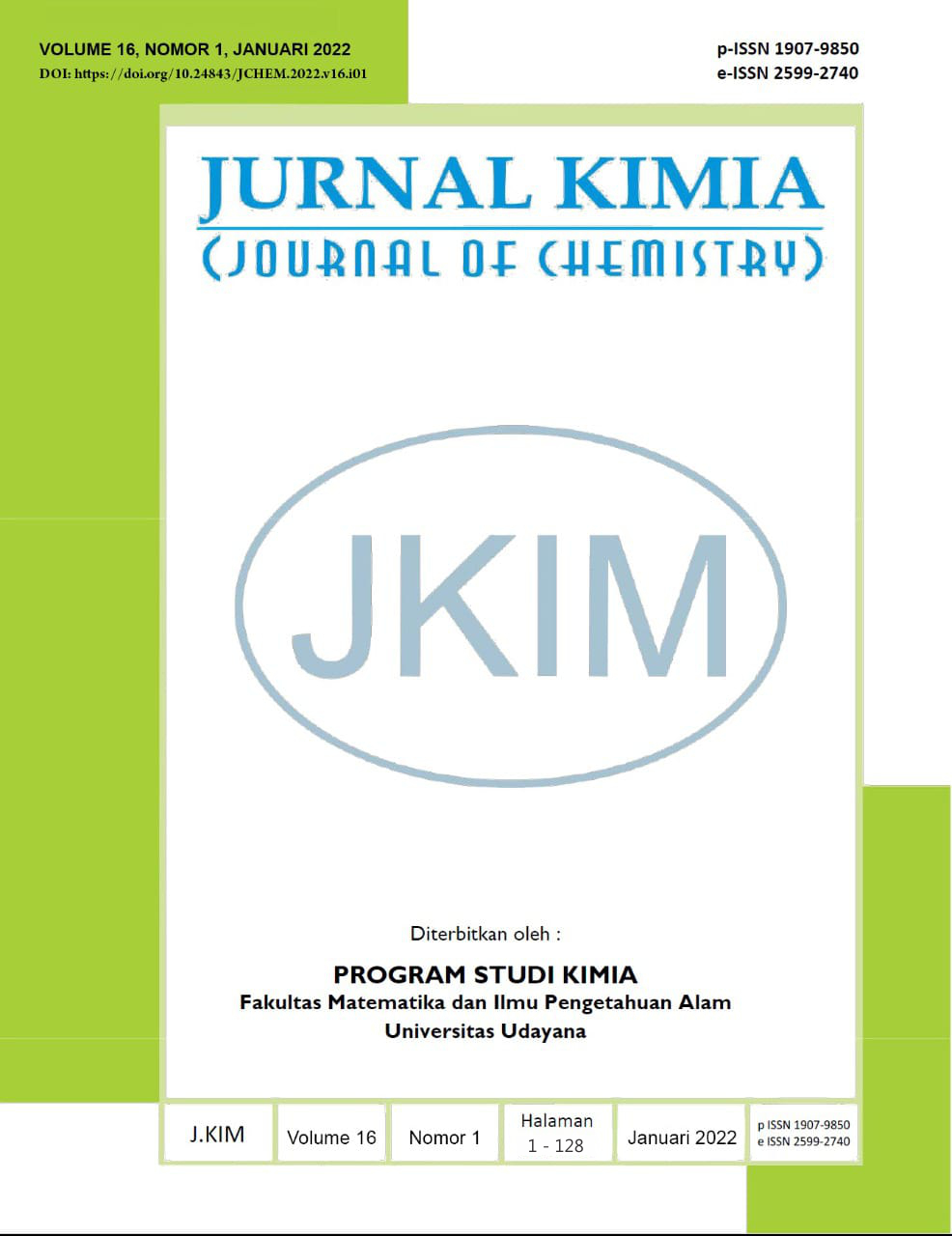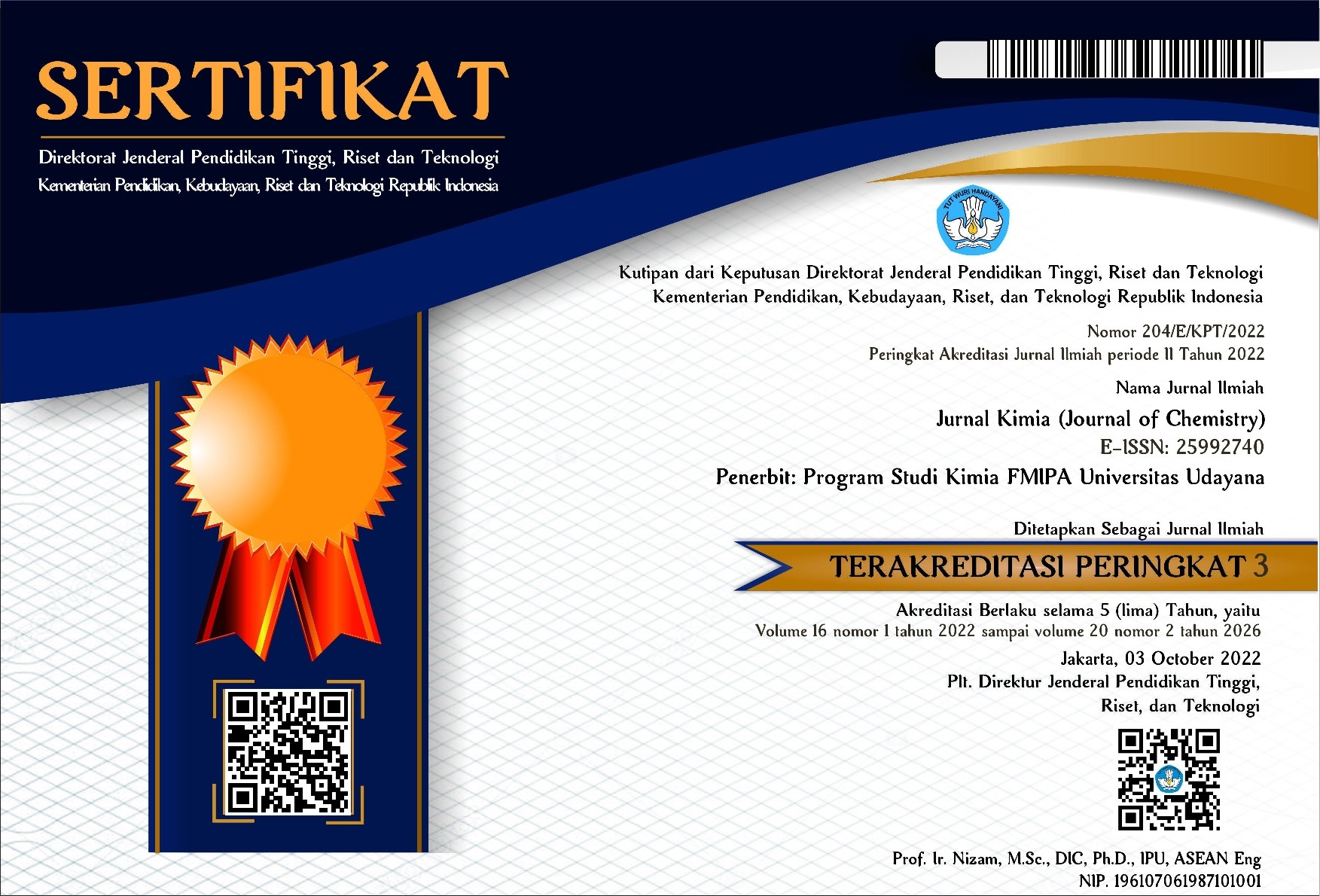BIOSORPSI Cr(III) OLEH BIOSORBEN KULIT KAPUK (Ceiba pentandra (L.) Gaertn) TERAKTIVASI ASAM NITRAT
Abstract
Kulit buah kapuk (Ceiba pentandra (L.) Gaertn) merupakan limbah pertanian yang kurang dimanfaatkan. Kulit buah kapuk mengandung senyawa organik seperti selulosa, hemiselulosa, dan lignin yang cukup tinggi. Komponen tersebut mengandung gugus hidroksil (-OH), karbonil (-C=O), dan karboksil (-COOH) yang dapat digunakan dalam proses biosorpsi. Penelitian ini bertujuan untuk mengetahui karakteristik biosorben kulit kapuk teraktivasi HNO3, kondisi optimum biosorpsi ion logam Cr (III), dan kapasitas biosorpsi biosorben kulit kapuk. Parameter yang dipelajari dalam penentuan karakteristik biosorben meliputi keasaman permukaan, jumlah situs akif, luas permukaan, dan gugus fungsi yang berperan dalam biosorpsi. Optimasi kondisi biosorpsi ion logam Cr (III) dilakukan dengan menentukan pH, waktu kontak, dan konsentrasi awal larutan Cr
(III). Hasil penelitian menunjukkan bahwa biosorben teraktivasi HNO3 0,02 M (BAN3) memiliki karakteristik keasaman permukaan, jumlah situs aktif, dan luas permukaan berturut-turut sebesar 17,79490,5999 mmol/g, 1,07160,0361×1022 molekul/gram, dan 36,941470,00158 m2/g. Kondisi optimum biosorpsi ion logam Cr (III) pada pH 5, waktu kontak 90 menit, konsentrasi awal larutan Cr (III) 1800 mg/L. Proses biosorpsi mengikuti pola isoterm Langmuir dengan nilai R2 sebesar 0,975 dan kapasitas biosorpsi sebesar 59,28 mg/g. Karakterisasi menggunakan FTIR menunjukkan bahwa biosorben mengandung gugus fungsi seperti –OH, C=O, C-O-H, dan C-O-C yang berperan dalam proses biosorpsi.
Kata kunci: Biosorpsi,biosorben, Cr (III), kulit buah kapuk.
Kapok husk (Ceiba pentandra (L.) Gaertn) is an under-utilized agricultural waste. Kapok husk contains quite high percentage of organic compounds such as cellulose, hemicellulose, and lignin. Those compounds contain hydroxyl groups (-OH), carbonyl group (-C=O), and carboxyl group (-COOH) that can be used in the biosorptions process. This study aimed to determine the characteristic of the biosorbent activated by HNO3, the optimum conditions of the Cr (III) biosorption, and the biosorption capacity of the biosorbent. The parameters studied for determining characteristics of the biosorbent were surface acidity, number of active sites, surface specific area, and functional groups that play a role in the biosorption. Optimation condition of the Cr (III) biosorption was carried out by determining the pH, contact time, and initial concentration of Cr (III). The result showed that the activated kapok husk powder with HNO3 0,02 M (BAN3) has characteristics of surface acidity, the number of active site and surface specific area of 17,79490,5999 mmol/g, 1,07160,0361×1022 molecule/gram and 36,941470,00158 m2/g respectively. The optimum conditions of the Cr (III) biosorption were obtained at pH 5, contact time 90 minutes, and initial concentration of Cr (III) at 1800 mg/L. Isotherm biosorption followed the Langmuir isotherm model with R2 value of 0,975 and biosorption capacity of 59,28 mg/g. Characterization using FTIR showed that biosorbent contained -OH, C=O, C-O-H, dan C-O-C functional groups which played a role in the biosorption process.
Keywords: Biosorption, biosorbent, Cr (III), kapok husk.
Downloads
References
APHA, AWWA, and WEF. 1999. Standard Methods for the Examination of Water and Wastewater, 20th ed. American Public Health Association. WashingtonD.C.
Bijang, C. M., Latupeirissa, J., dan Ratuhanrasa, M. 2018. Biosorpsi Ion Logam Tembaga (Cu2+) Pada Biosorben Rumput Laut Coklat (Padina australis). Indo. J. Chem. 6(1): 26-37.
Chun, K. S., Husseinsyah, S. and Yeng, C. M. 2015. Green Composites from Kapok Husk and Recycled Polypropylene: Processing torque, tensile, thermal, and morphological properties. Journal of Thermoplastic Composite Materials. 29(11): 1517-1535.
Dwipayana, A.A.G.A. S, Sudiarta, I. W, dan Budiarsa, S.I.W. 2017. Karakteristik dan Kapasitas Biosorben Kulit Jeruk Siam Lumanjang (Citrus nobilis Tan.) Teraktivasi H2SO4 dalam Menurunkan Kadar Ca dan Mg dalam Air. Jurnal Kimia. 11(1): 30-35.
Edelynna, A.M.O., Wirespathi, Raharjo, dan Widowati, B. 2012. Pengaruh Kromium Heksavalen (VI) terhadap Tingkat Kelangsungan Hidup Ikan Nila (Oreochromis niloticus). Jurnal LenteraBio.1(2): 75-79.
Krismayanti, N.P., Manurung, M., dan Suastuti, N.G.A.M.D.A. 2019. Sintesis Arang Aktif Dari Limbah Batang Bambu Dengan Aktivator NaOH Sebagai Adsorben Ion Krom (III) dan Timbal (II). Cakra Kimia. 7(2): 189-197.
Kusumawardani, R., Zaharah, T. A., dan Destiarti, L. 2018. Adsorpsi Kadmium (II) Menggunakan Adsorben Selulosa Ampas Tebu Teraktivasi Asam Nitrat. Jurnal Kimia Khatulistiwa.7(3): 75-83.
Mufrodi, Z., Nur, W., dan Ranny, C. K. 2008. Adsorpsi Zat warna Tekstil dengan Menggunakan Abu Terbang (Fly Ash) untuk Variasi Massa Adsorben dan Suhu Operasi. Prosiding: Seminar Teknoin, Bidang Teknik Kimia dan Tekstil. Yogyakarta.
Nurafriyanti, Prihatini, N.S., dan Syauqiah, I. 2017. Pengaruh Variasi pH dan Berat Adsorben Dalam Pengurangan Konsentrasi Cr Total pada Limbah Artifisial Menggunakan Adsorben Ampas Daun Teh. Jukung Jurnal Teknik Lingkungan. 3(1): 56-65.
Putra, I. T. 2014. Karakteristik Kimia Kulit Kapuk Randu Sebagai Bahan Energi Biomassa. Skripsi. Institut Pertanian Bogor. Bogor.
Ramalingam, S., Parthiban, L., and Rangasamy, P. 2014. Biosorption Modeling with Multilayer Percepton for Removal of Lead and Zinc Ions Using Crab Shell Particles. Arab J Sci Eng.39: 8465-8475.
Sudiarta, I.W. 2009. Biosorpsi Ion Cr (III) Pada Rumput Laut Eucheuma spinosum Teraktivasi Asam Sulfat. Jurnal Kimia. 3(2): 93-100.
Sudiarta, I.W., Diantariani, N.P., dan Yulihastuti, D.A. 2012. Biosorpsi Cr (III) Pada Biosorbent Serat Sabut Kelapa Hijau Teraktivasi Asam Nitrat. Chem. Prog. 5(1): 25-30.
Sudiarta, I.W. dan Sulihingtyas, D.W. 2012. Biosorpsi Cr (III) Pada Biosorben Serat Sabut Kelapa Hijau Teramobilisasi EDTA. Jurnal Kimia.6(1): 29-36
Wogo, H.E., Kadang, L., dan Mir, M.A. 2014. Termodinamika Adsorpsi Ca (II) dan Cd (II) Pada Adsorben Ampas Tahu. Sains dan Terapan Kimia. 8(2): 120-128.
Zein, R., Nofita, D., Refilda, dan Aziz., H. 2019. Penyerapan Timbal (II) dan Cadmium (II) di dalam Larutan Menggunakan Kulit Buah Kapuk. Jurnal Chimica et Natura Acta. 7(1): 37-45.

This work is licensed under a Creative Commons Attribution 4.0 International License






